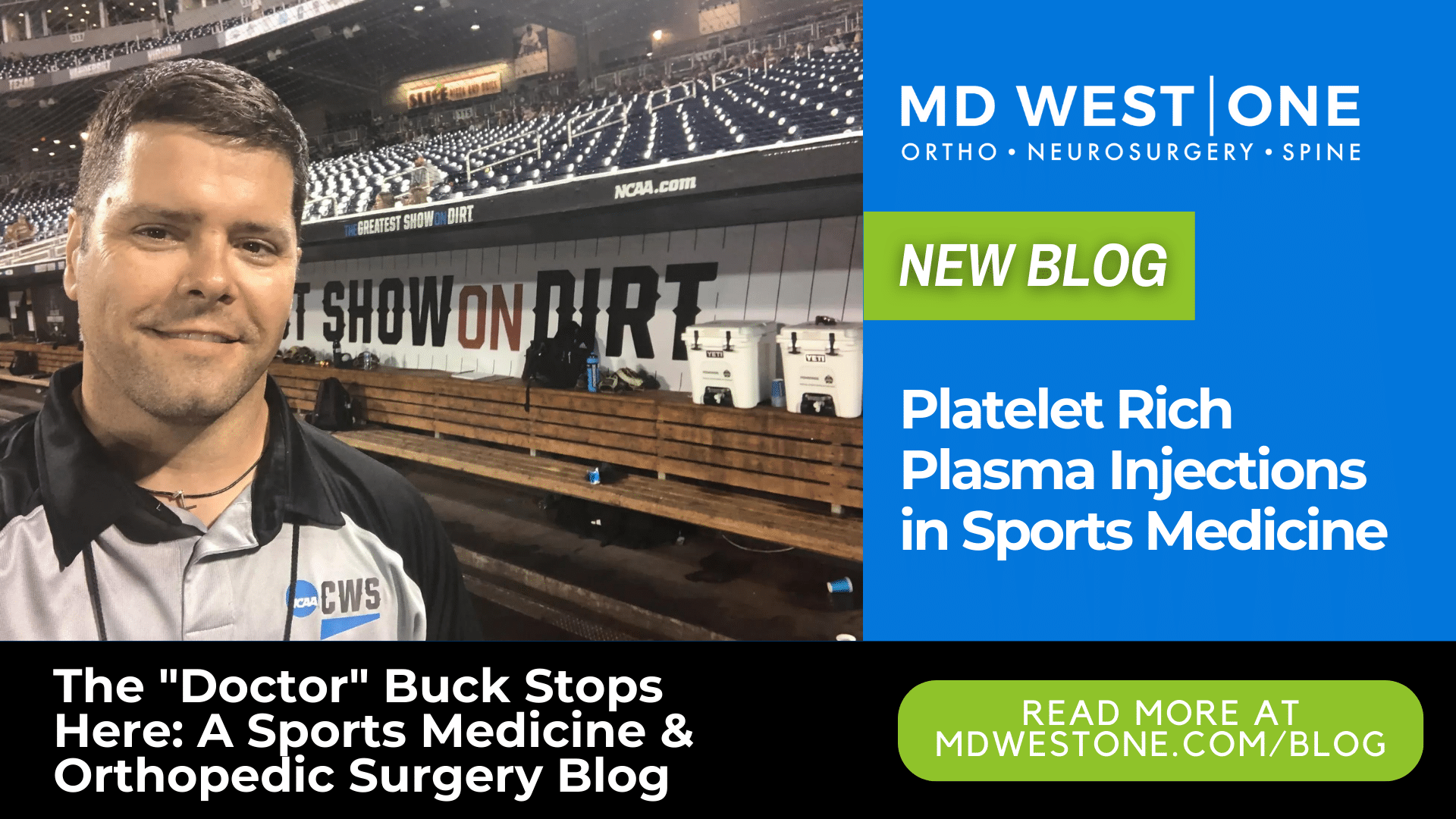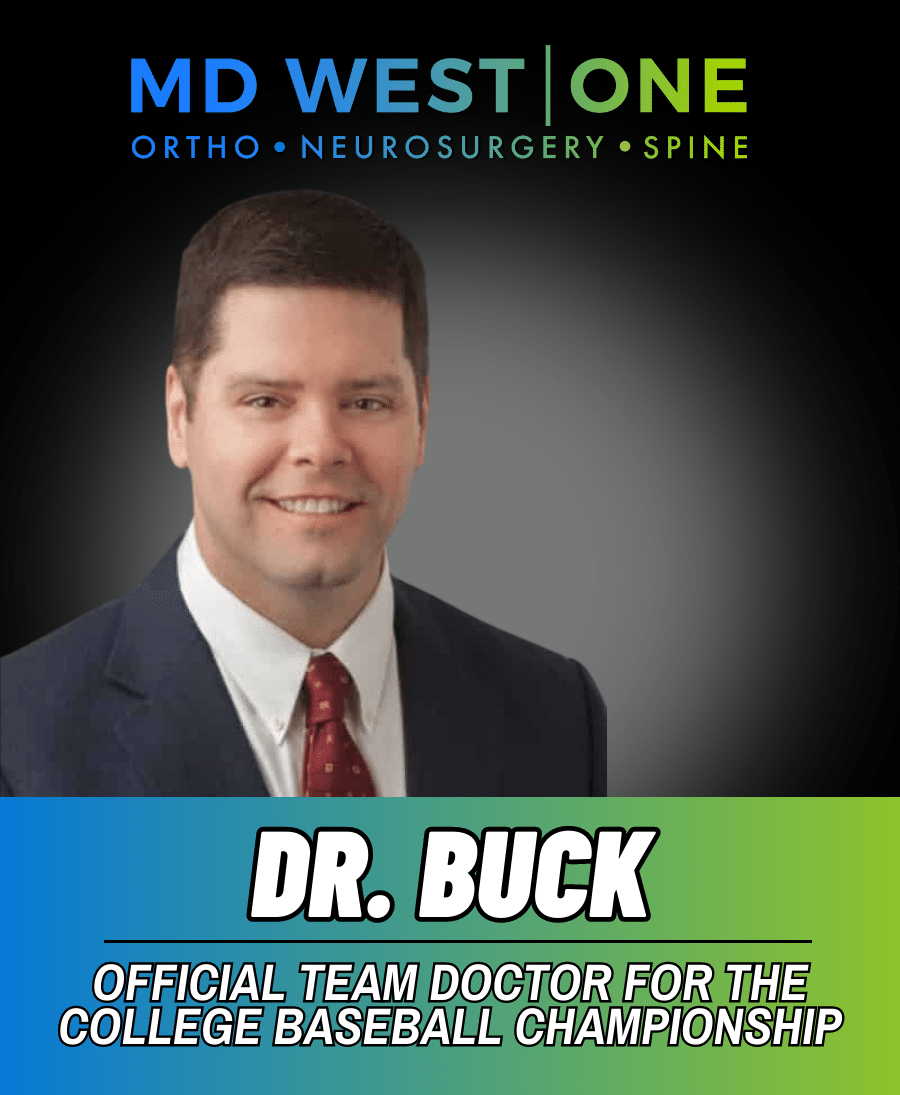
Authored by: David C. Buck, M.D. - Orthopedic Surgeon and Sports Medicine Specialist at MD West ONE (Omaha and Fremont, Nebraska)
What is Platelet Rich Plasma (PRP)?
Platelets are cells in the blood that we have always known help with blood clotting. More recently, we know that platelets release growth factors that are responsible for tissue healing. We obtain platelets from your blood and concentrate them with a centrifuge. This fluid is a concentrated collection of healing potential that we can use to aid the body’s own natural healing response by stimulating an increase in blood supply to an injured area.
How is PRP used in orthopedic surgery?
PRP is an emerging treatment in orthopedic surgery and sports medicine. The philosophy is to merge this technology with the body's natural ability to heal itself. PRP therapy offers a promising solution to accelerate healing of soft tissue injuries and osteoarthritis naturally. It is used both in the office and the surgery setting.
What conditions are treated with PRP?
Based on current research, soft tissue injuries are the most responsive to PRP. I have used PRP in the sports medicine realm to treat tendon injuries such as tennis elbow and tendonitis, patellar tendonitis or “Jumper’s Knee”, rotator cuff inflammation and partial thickness tears, Achilles tendonitis, ligament sprains, and muscle tears and strains.
PRP has also been effective in early studies in treating cartilage degeneration found with arthritis. These PRP injections have been shown to be as or more effective than other treatment modalities for treating arthritis. Additional studies are underway to further delineate their benefit.
Studies have also shown benefit with trigger point injuries, whiplash injuries, and helping to heal troublesome fractures (broken bones).
Who is a candidate for PRP injections?
Platelet-rich plasma therapy may be a good option for an athlete or active individual who has a painful soft tissue injury or degenerative arthritis with NO clear and present signs of structural damage or full-thickness tearing. It is not always used in place of surgery in these conditions.
Candidates should be in good overall health with no known blood related conditions (leukemia or lymphoma), not currently using anticoagulation medicines (blood thinners), and have no active infection at the site of the injection.
Instructions for before the procedure.
Stop taking drugs and supplements that can affect the platelets for one week before and after PRP therapy. These include the following medications: NSAIDs (eg: Ibuprofen, Aleve, Naproxen, Aspirin, Motrin, Voltaren, Diclofenac) and herbal supplements. You can safely take Acetaminophen (Tylenol) if needed for pain, at any time leading up to the injection.
How is PRP treatment administered?
First, some of the patient’s blood is collected with a needle and syringe under sterile conditions. This blood is then spun down in a centrifuge specifically designed to concentrate platelets for PRP purposes.
Second, the injured area is prepared in a sterile fashion to reduce the risk of infection and a topical anesthetic is provided to the area.
Third, the injection is provided with a small-bore needle at the site of injury and maximal discomfort using the Sonosite ultrasound to specifically guide the injection to the injured area. One to three treatments will be provided depending on the injury and location.
Typically, we can repeat a 2nd and 3rd injection at 4 and 8 weeks if necessary.
What can you expect after getting PRP?
For the first 48 hours, swelling and soreness are typical in the injected area. All patients are encouraged to ice the area as needed following the injection. Try to minimize activity to normal day to day walking for the first two days. By day 3-5, these symptoms will begin to resolve. Avoid heavy physical activity for 7-10 days post injection. Avoid NSAID’s (see above list) for two weeks following the injection. Follow-up with your physician will be 2-4 weeks later. Most patients notice an improvement in 4-8 weeks following their first injection. Patients often report that their original pain is replaced by a dull soreness that will improve over time. Increased strength and endurance are reported over about 12 weeks. Unfortunately, not every patient will show improvement with PRP and may require additional treatment or surgery.
Is PRP covered by my health insurance?
At this time (June 2023) most insurance companies consider PRP to be ‘experimental’ and do not cover the treatment. Currently, our office has a flat charge per injection, payable at the time of the procedure. This covers the cost of the office the single-use PRP kit and the use of the medical grade centrifuge. It also covers the cost of the office visit, the injection, and the use of the Sonosite Ultrasound. This will NOT be submitted to your insurance company.
Is there medical literature to support these injections?
Knee pain and functions scores (WOMAC) improved 78% at one year following PRP injections for knee OA vs. 7% for placebo. (Smith P,American Journal of Sports Medicine, 2016).
Knee pain and function scores (WOMAC) improved significantly vs. hyaluronic acid injections for knee OA at both 3 and 12 months. (Meheux CJ, Arthroscopy, 2017)
PRP injection shows an effective reduction in pain according to VAS and MAYO score and especially, younger age patients have shown more benefit in terms of pain reduction with PRP treatment. (Paramanantham M, Cureus, 2022).
PRP can reduce pain associated with lateral epicondylitis and rotator cuff injuries. (Chen X, Amer Journal Sports Medicine, 2018).
PRP treatment demonstrated significant improvements in terms of pain relief and functional improvement in tennis elbow patients. (Shangzhe L, Journal Shoulder Elbow Surgery, 2022).
What are the risks of PRP injections?
1. Pain in the area of the injection: A moderate amount of discomfort is expected due to the inflammation caused by the injection. This increased inflammation if one of the ways that PRP promotes healing. Inflammation results in an environment that can promote the repair of the damaged tissues into which the blood has been injected, however it also causes swelling and pain. You may choose to take a pain reliever such as Tylenol® (acetaminophen) to treat this discomfort if regular cold packs are not providing relief.
2. Infection: The risk of infection is extremely low. Studies have shown the risk of infection after an injection is 1 in 10,000 injections. Signs of infection include fever, chills, and pain, warmth and redness around the area of the injection. Symptoms of an infection could occur up to 10 days after the injection. If you have any of these symptoms please call our office.
3. Allergic Reaction: PRP is made from your own blood and this makes it very unlikely that you will have an allergic reaction. Allergic reactions following PRP injections are considered very rare.
4. Bruising: Sometimes the skin around the area of the PRP injection will appear bruised. This could be normal, based upon your history of bruising.
5. No Improvement in symptoms: While this is not necessarily a side-effect, it is important that you know that not all patients respond to a PRP injection. Sometimes the original pain and soreness of the injury remains (it may even get worse), even after an extended rest period after the PRP therapy.
6. Concerns?
Please contact our office if you have concerns or questions about the procedure.
About Dr. Buck:
Dr. David Buck is a Board Certified Orthopedic Surgeon with a Certificate of Added Qualification as a Sports Medicine Specialist with MD West ONE.
Dr. Buck serves as the Team Physician for Midland University and also is a part of the Sports Medicine team providing coverage for the NCAA College World Series in Omaha. He works closely with several local area high schools and their sports medicine programs. Dr. Buck is a former Certified Athletic Trainer as well as an athlete and coach. He can be reached at (402) 721-0090 to schedule an appointment at either our Elkhorn (192nd & Dodge) or Fremont locations.

